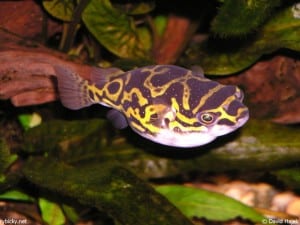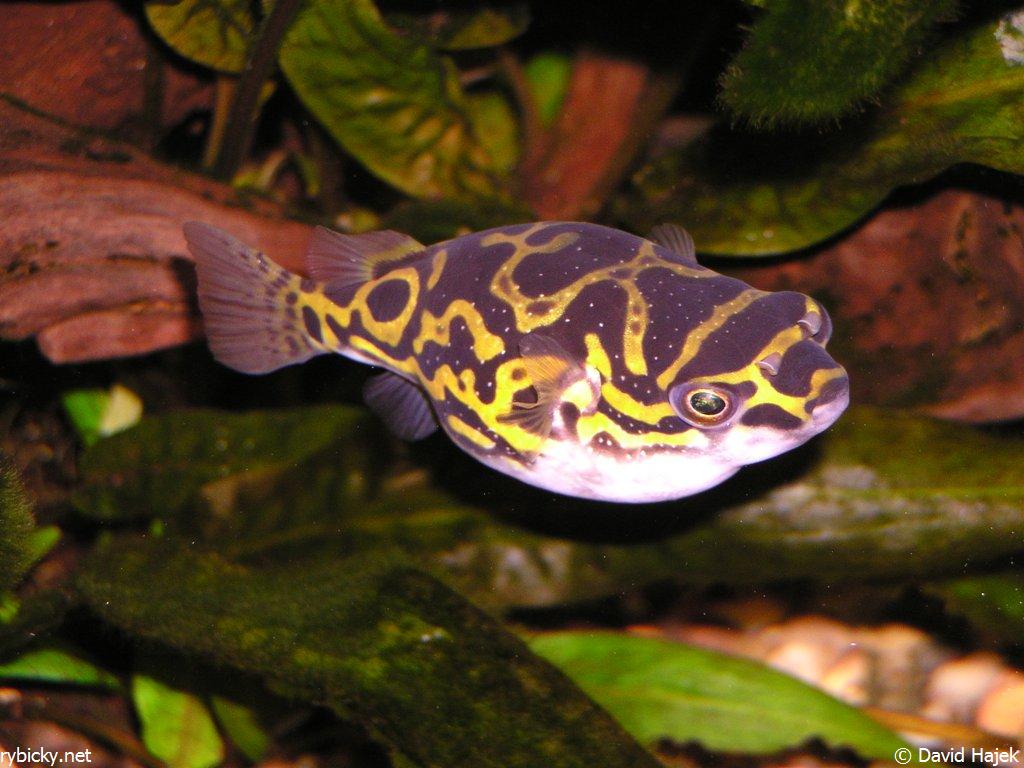
Common name: Figure Eight Puffer
Scientific name: Tetraodon Biocellatus
Average Adult Fish Size: 8 cm / 3.2 inches
Place of Origin: Cambodia, Malaysia, Indonesia. Lives in rivers and coastal waters. It’s found most often in freshwater, but also is found in brackish conditions.
Typical Tank setup: Best kept in a planted setup with lots of bog wood and branches to provide additional cover. Leave some open spaces in-between for swimming, as this is an active species. The use of a sandy substrate and floating plants to diffuse the light is also recommended. The puffer is very sensitive to deteriorating water conditions, so regular partial water changes are a must.
Recommended Minimum Aquarium Capacity: 18 gallon / 70 litre
Compatibility: Can be kept in a community tank, but caution should be taken when choosing tank mates, as it tends to nip the fins of slow-moving or long-finned fish. In freshwater, it does well with fast-moving species such as danios, rasboras and barbs. In a brackish community tank mates can include monos, bumblebee gobies and salt-tolerant Chanda species.
If you want to keep more than one puffer, try to buy at least four fish, so that any aggression is dispersed between the group.
Temperature: 22 – 26 Deg C / 72 – 79 Deg F
Water chemistry: pH 6.5 to 7.5
Feeding: Loves all types of shellfish, as well as worms and other live and frozen foods. It should be fed snails and unshelled shellfish (such as crab legs, prawns etc.) regularly, in order to take care of and preserve its sharp teeth. As with other puffers, these grow all the time and become a problem for the fish if they’re not kept ground down.
Sexing: Adult females may grow larger than males. However this is incredibly difficult to notice.
Breeding: Not Unknown in the hobby. However there have been reports it’s a substrate spawner and the male exhibits some signs of brood care.
Additional Information: The reason the Puffer fish are called Puffer fish is that they have the ability to inflate their elastic stomachs with water or air. This is usually a response to some kind of threat, although in the tank many specimens appear to inflate themselves for no reason at all. The fish becomes 2 or 3 times its normal size, big enough to scare away many potential predators, or difficult to swallow.
Puffers also have several other interesting distinctive features. They are one of the few fish that can actually blink or close their eyes. This only adds further charm to what is already a fish with bags of personality. They also have beak-like mouthparts, which are formed by a fusing of 2 teeth from each jaw. These are used to crush shells, the favourite food of most puffers.


Related Posts
Croaking Gourami – Trichopsis vittatus
Benthochromis Tricoti
Large-eyed Mouthbrooder – Callochromis Macrops